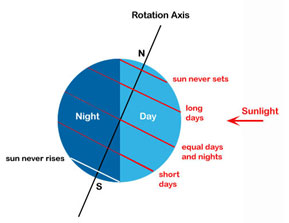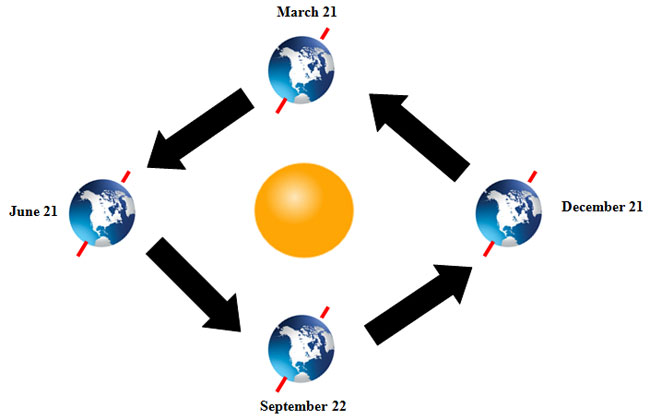
Source: Earth on Revolution Around the Sun, Palomar College
In addition to rotating on its axis, the Earth also travels around the sun in a path called an orbit. The motion around the sun along its orbit is called a revolution. The amount of time it takes for a single trip around the sun is called a period of revolution. The period for the Earth to revolve around the sun is 365.24 days or one year. The .24 days is why every four years February has 29 days.
Earth's orbit is not a perfect circle. Instead Earth's orbit is slightly elliptical in shape. The animation below shows the Earth's revolution around the sun.

Source: Earth on Revolution Around the Sun, Palomar College

Source: Earth on its Axis, Department of Astronomy and Astrophysics, Penn State University
A common misconception many people have is that the seasons are caused by the distance of the Earth from the sun. This is not true. Because Earth's orbit around the sun is slightly elliptical, Earth is actually slightly closer to the sun in the winter than it is in the summer.
Remember that in section 2 of this lesson we discussed that Earth's axis was tilted about 23.5 degrees. It is the tilt of Earth's axis that causes the seasons.
The following diagram shows Earth's revolution during different times of the year. Pay close attention to the direction of the Earth's titled axis.

An imaginary line, the equator, runs horizontally around the center of the Earth dividing Earth into two hemispheres. The area above the equator is referred to as the Northern Hemisphere while the area below the equator is called the Southern Hemisphere.

Source: Earth with the Equator, Cburnett, Wikispaces

Texas is in the Northern Hemisphere. During our summer we have warmer temperatures and longer days because the Northern Hemisphere is tilted toward the sun and receives more solar energy. However, the Southern Hemisphere has colder temperatures and shorter days because it is tilted away from the sun. This would be the Southern Hemisphere's winter

When the Northern Hemisphere is tilted away from the sun, we experience winter in Texas. The temperatures are lower and the days are shorter because we are receiving less solar energy. However the Southern Hemisphere is tilted toward the sun causing higher temperatures and longer days. This would be the Southern Hemisphere's summer.

During what months does Australia have summer?
Interactive popup. Assistance may be required. Australia is located in the Southern Hemisphere which experiences summer when Earth is tilted toward the sun. The Southern Hemisphere is tilted toward the sun December - February.